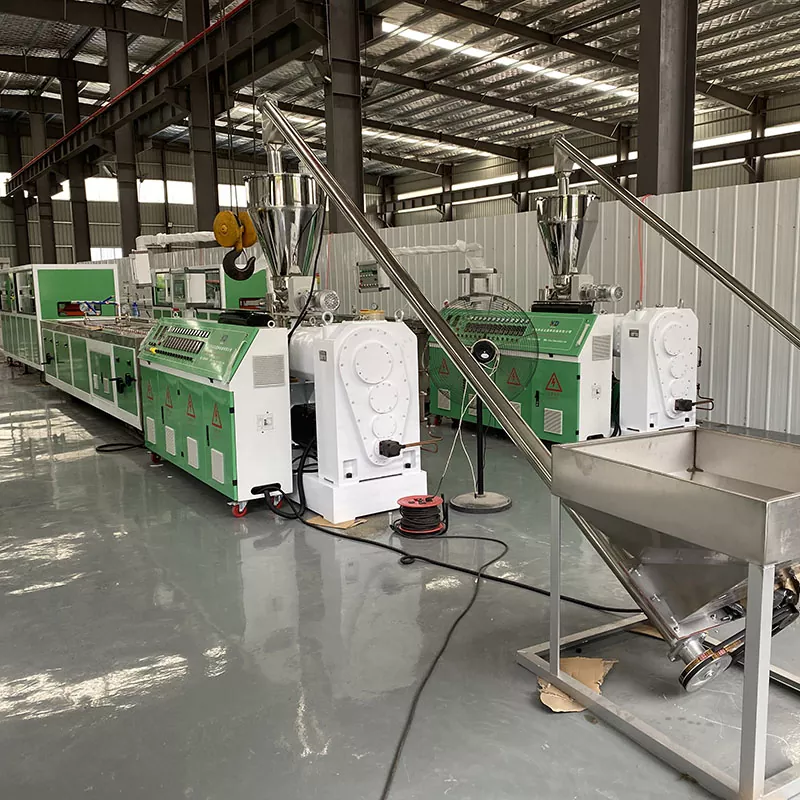PVC profile (polyvinyl chloride profile) is a plastic profile widely used in the fields of construction, home furnishing, decoration, etc. The features of PVC Profile Production Line and its products are as follows:
Raw material ratio and mixing: PVC resin powder (main raw material), stabilizer (such as lead salt, calcium zinc), plasticizer (DOP/DOA), lubricant, filler (such as calcium carbonate), colorant (titanium dioxide), impact modifier (such as CPE), etc. High-speed mixing: Put the raw materials into the high-speed mixer in proportion and stir at high temperature (110~120℃) to make the components evenly dispersed and form a pre-plasticized state. Cooling and mixing: Transfer the hot mixture to the cold mixer to cool down to 40~50℃ to prevent agglomeration.
Extrusion molding. Extruder: The mixture is heated and plasticized by a single/twin screw extruder (temperature segment control: 160~190℃), and extruded by a mold (die). Mold design: customized according to the cross-sectional shape of the profile (such as the hollow structure of the door and window profile), controlling the dimensional accuracy and surface finish.
Cooling and shaping. Vacuum shaping table: the extruded profile enters the water-cooled shaping mold and is quickly shaped through vacuum adsorption and circulating water cooling. Spray cooling: further spray water to cool to room temperature to ensure the dimensional stability of the profile.
Traction and cutting. Traction machine: traction profile at a uniform speed to ensure that the extrusion speed is synchronized with the traction to avoid deformation. Cutting machine: automatic cutting according to the set length (such as 6 meters), the incision must be flat and burr-free.
Post-processing and quality inspection. Surface treatment: some products require lamination, coating or printing (such as imitation wood grain). Quality inspection: check dimensional tolerance, surface defects, mechanical properties (impact resistance, tensile strength), etc. Packaging: labeling, bundling, moisture-proof and scratch-proof packaging.

Architectural door and window profiles: sliding windows, casement windows, door frames, sealing strips, etc. Features: hollow multi-cavity structure, heat insulation and sound insulation, anti-aging, various colors (mainly white, customizable colors).
Decorative profiles: skirting, corner lines, wall panels, decorative lines, etc. Features: imitation wood grain and stone grain on the surface, light and easy to install, waterproof and moth-proof.
Furniture profiles: cabinet edge banding, drawer slides, furniture frames. Features: wear-resistant, easy to clean, environmentally friendly and formaldehyde-free.
Industrial profiles: pipes, electrical conduits, ventilation ducts, equipment protective covers. Features: corrosion resistance, good insulation, high strength.
Raw material purity: avoid impurities affecting product performance. Temperature control: PVC Profile Production Line extrusion temperature is too high and easy to decompose, too low plasticization is poor. Mold precision: determines the cross-sectional shape and dimensional stability of the profile. Cooling efficiency: prevent shrinkage deformation or residual internal stress.
Lead-free formula: promote calcium zinc stabilizers to replace traditional lead salts. Recycling: Waste profiles are crushed and re-granulated for low-end products. High performance: Develop high impact and weather-resistant profiles (such as ASA co-extruded outer layer). By optimizing the PVC Profile Production Line and material formulation, PVC profiles continue to play an important role in the field of energy-saving buildings and homes.